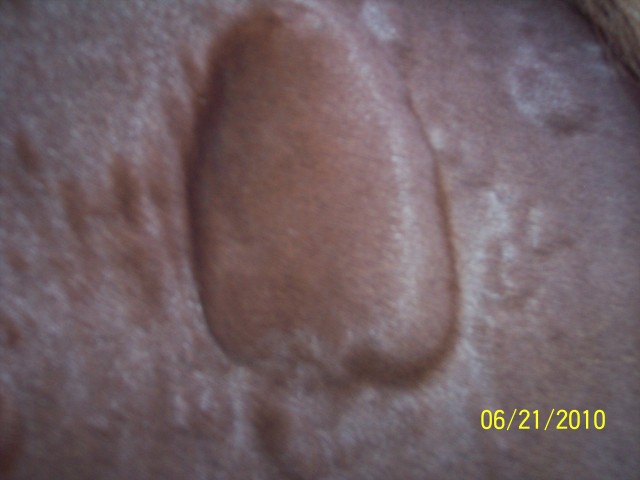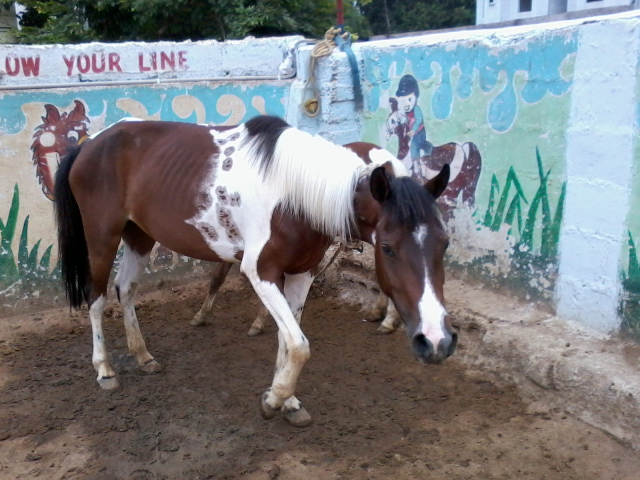QuestionWe are doing so well with our rescue horses! Right now we are trying to halter train them. They are like old mules! I have been reading alot on how to do this properly. The experts say not to pull on your horses halter, or just apply pressure till they give in to it. I will apply pressure to the halter(I have the lead rope fastened to the ring under the jaw)I will then ask the horse to move forward by standing just in front of the shoulder and lean forward and take a step and click or make kissy noises and say walk!I will sometimes hold the pressure on for as long as 5 minutes or more with her head streched out and still she wont move a step. When she does finally I will praise and pet her. When she does get going its not for very long till we have to do it all over again. What can I do? The 6 yr old gelding does better but he likes to jump around and try to run over you at times. But you can lead him anywhere.
Thanks for any helpful tips you may have! Stacy
-------------------------
Followup To
Question -
My husband and I just bought 2 rescue horses. The mare is 6 and the gelding is 5. They are brother and sister (we think) They are almost identical. They are very attached to one another. I Have not had a horse for about 15 yrs. These horses need to learn everything! Hank is alot more people friendly then the mare. She is very head shy. I can brush her and wipe her down with bug block, but she has a mess of sticky burrs in her bangs that she wont let me get out! Also some really big halter sores That need ointment. They are both coming along nicely with the help of some sweet feed. Untill they came to us 4 days ago they had never been introduced to grain. We are very careful on how much we give them. About a cup each. Please advise us as where to start with training them. They are Red Roan Appaloosas. We have a vet and Ferrier for them so everything is covered on that end of things. We just dont want to overwhelm them with being to pushy getting them to accept us. Any tips would be great! Thank You Ever So Much! Stacy
Answer -
Hi Stacy.
First of all I would like to congratualte you on your new horses, you are doing a wonderful thing in taking them in.
The sweet feed is the first thing I would like to address. I would not advise sweet feed for horses that may have had poor nutrition as it is very rich, high in protein etc. I would suggest a complete pellet feed with a lower protein content mixed with some chaff and beet pulp soaked overnight before feeding if they require to put on weight. Sweet feed in general is likely to produce a jumpy horse and predisposes to colics etc.
The first step in training them is to desensitise them to your presence, it sounds like you are doing a great job with this already, spend time brushing them and also spend time just being in their paddock without trying to push yourself near them, just hang out - perhaps take a book to read or something and then if they come over to investigate be ready with the feed or a horse biscuit so they learn to associate you with good things.
One of the main things though is not to be too hesitant. If you are hesitant in approaching them they will be more hesitant. Be firm and act like you've been working with them every day for years, speak in a normal low soothing voice to them rather than hushed voices and move confidently just not too fast and as gently as possible - but dont tickle them when you stroke them, they will get used to a firm touch faster than a tickle.
Once they are used to you and you can halter them, lead them around calmly at a walk, brush them (dont worry about the head-shyness for a while) etc then I would recommend trying join-up with them. You can buy video cassettes/dvds of "how to join up" by Monty Roberts which are an excellent tool to gaining the trust of young or nervous horses and in teaching them respect for you.
Good luck with this stage of the process please let me know how you get on and if you need any further help once you have the haltering and ground manners down.
Sarah
AnswerHi again
With your gelding you need to be firmer! if he jumps sideways or barges at you, get after him and make him respect your personal space. Stop him completely and position him in an appropriate way next to you then continue. It may take him a while but he will get the hang of it.
With the mare you will need to take a little different approach. Tugging on her headcollar alone will not encourage her to move forwards. Horses are "into pressure" animals which means she will pull against you when you pull the headcollar. Carry with you a short whip or crop and when you ask her to move forwards just tickle her with it, not a hit that might make her whip shy just a little prod or light tap in her side. (it may be best to get a second person to do this) The minute she moves ease up the pressure on both the headcollar and whip but as soon as she stop get after her again until eventually she gets the idea that you want her to go forwards when you click at her.
Hope this helps
Sarah

 Sores on horses
QuestionQUESTION: this is kinda gross so i apologize to
Sores on horses
QuestionQUESTION: this is kinda gross so i apologize to
 Bumps all over my horse
Question
under mane
I just went down to pasture to chec
Bumps all over my horse
Question
under mane
I just went down to pasture to chec
 ponies breed
Question
ponies
hello Dorothy. may i know which
ponies breed
Question
ponies
hello Dorothy. may i know which
 blistered legs
Question
blistered legs
hello. are these blister
blistered legs
Question
blistered legs
hello. are these blister
 posting slightly at canter
Question
marina
hello Dorothy. when i was trotti
posting slightly at canter
Question
marina
hello Dorothy. when i was trotti